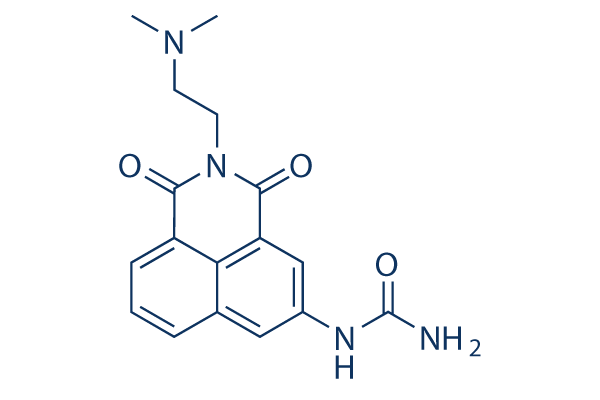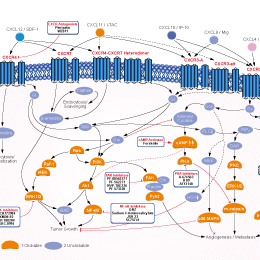
- Bioactive Compounds
- By Signaling Pathways
- PI3K/Akt/mTOR
- Epigenetics
- Methylation
- Immunology & Inflammation
- Protein Tyrosine Kinase
- Angiogenesis
- Apoptosis
- Autophagy
- ER stress & UPR
- JAK/STAT
- MAPK
- Cytoskeletal Signaling
- Cell Cycle
- TGF-beta/Smad
- DNA Damage/DNA Repair
- Compound Libraries
- Popular Compound Libraries
- Customize Library
- Clinical and FDA-approved Related
- Bioactive Compound Libraries
- Inhibitor Related
- Natural Product Related
- Metabolism Related
- Cell Death Related
- By Signaling Pathway
- By Disease
- Anti-infection and Antiviral Related
- Neuronal and Immunology Related
- Fragment and Covalent Related
- FDA-approved Drug Library
- FDA-approved & Passed Phase I Drug Library
- Preclinical/Clinical Compound Library
- Bioactive Compound Library-I
- Bioactive Compound Library-Ⅱ
- Kinase Inhibitor Library
- Express-Pick Library
- Natural Product Library
- Human Endogenous Metabolite Compound Library
- Alkaloid Compound LibraryNew
- Angiogenesis Related compound Library
- Anti-Aging Compound Library
- Anti-alzheimer Disease Compound Library
- Antibiotics compound Library
- Anti-cancer Compound Library
- Anti-cancer Compound Library-Ⅱ
- Anti-cancer Metabolism Compound Library
- Anti-Cardiovascular Disease Compound Library
- Anti-diabetic Compound Library
- Anti-infection Compound Library
- Antioxidant Compound Library
- Anti-parasitic Compound Library
- Antiviral Compound Library
- Apoptosis Compound Library
- Autophagy Compound Library
- Calcium Channel Blocker LibraryNew
- Cambridge Cancer Compound Library
- Carbohydrate Metabolism Compound LibraryNew
- Cell Cycle compound library
- CNS-Penetrant Compound Library
- Covalent Inhibitor Library
- Cytokine Inhibitor LibraryNew
- Cytoskeletal Signaling Pathway Compound Library
- DNA Damage/DNA Repair compound Library
- Drug-like Compound Library
- Endoplasmic Reticulum Stress Compound Library
- Epigenetics Compound Library
- Exosome Secretion Related Compound LibraryNew
- FDA-approved Anticancer Drug LibraryNew
- Ferroptosis Compound Library
- Flavonoid Compound Library
- Fragment Library
- Glutamine Metabolism Compound Library
- Glycolysis Compound Library
- GPCR Compound Library
- Gut Microbial Metabolite Library
- HIF-1 Signaling Pathway Compound Library
- Highly Selective Inhibitor Library
- Histone modification compound library
- HTS Library for Drug Discovery
- Human Hormone Related Compound LibraryNew
- Human Transcription Factor Compound LibraryNew
- Immunology/Inflammation Compound Library
- Inhibitor Library
- Ion Channel Ligand Library
- JAK/STAT compound library
- Lipid Metabolism Compound LibraryNew
- Macrocyclic Compound Library
- MAPK Inhibitor Library
- Medicine Food Homology Compound Library
- Metabolism Compound Library
- Methylation Compound Library
- Mouse Metabolite Compound LibraryNew
- Natural Organic Compound Library
- Neuronal Signaling Compound Library
- NF-κB Signaling Compound Library
- Nucleoside Analogue Library
- Obesity Compound Library
- Oxidative Stress Compound LibraryNew
- Plant Extract Library
- Phenotypic Screening Library
- PI3K/Akt Inhibitor Library
- Protease Inhibitor Library
- Protein-protein Interaction Inhibitor Library
- Pyroptosis Compound Library
- Small Molecule Immuno-Oncology Compound Library
- Mitochondria-Targeted Compound LibraryNew
- Stem Cell Differentiation Compound LibraryNew
- Stem Cell Signaling Compound Library
- Natural Phenol Compound LibraryNew
- Natural Terpenoid Compound LibraryNew
- TGF-beta/Smad compound library
- Traditional Chinese Medicine Library
- Tyrosine Kinase Inhibitor Library
- Ubiquitination Compound Library
-
Cherry Picking
You can personalize your library with chemicals from within Selleck's inventory. Build the right library for your research endeavors by choosing from compounds in all of our available libraries.
Please contact us at [email protected] to customize your library.
You could select:
- Antibodies
- Bioreagents
- qPCR
- 2x SYBR Green qPCR Master Mix
- 2x SYBR Green qPCR Master Mix(Low ROX)
- 2x SYBR Green qPCR Master Mix(High ROX)
- Protein Assay
- Protein A/G Magnetic Beads for IP
- Anti-Flag magnetic beads
- Anti-Flag Affinity Gel
- Anti-Myc magnetic beads
- Anti-HA magnetic beads
- Magnetic Separator
- Poly DYKDDDDK Tag Peptide lyophilized powder
- Protease Inhibitor Cocktail
- Protease Inhibitor Cocktail (EDTA-Free, 100X in DMSO)
- Phosphatase Inhibitor Cocktail (2 Tubes, 100X)
- Cell Biology
- Cell Counting Kit-8 (CCK-8)
- Animal Experiment
- Mouse Direct PCR Kit (For Genotyping)
- New Products
- Contact Us
UNBS5162
UNBS5162 is a pan-antagonist of CXCL chemokine expression with in vitro cytotoxic activity (IC50 range of 0.5-5 µM) against a range of human cancer cell lines including glioblastoma (Hs683 and U373MG), colorectal (HCT-15 and LoVo), non-small-cell lung (A549) and breast (MCF-7).

UNBS5162 Chemical Structure
CAS No. 956590-23-1
Purity & Quality Control
Batch:
S886901
DMSO]17 mg/mL]false]Water]Insoluble]false]Ethanol]Insoluble]false
Purity:
99.98%
99.98
UNBS5162 Related Products
| Related Targets | CXCR1 CXCR2 CXCR4 CXCR3 | Click to Expand |
|---|---|---|
| Related Products | SB225002 WZ811 Reparixin (Repertaxin) LIT-927 Navarixin (SCH-527123) LY2510924 AZD5069 AMD3465 hexahydrobromide AMG 487 SX-682 Danirixin (GSK1325756) MSX-122 | Click to Expand |
| Related Compound Libraries | Kinase Inhibitor Library FDA-approved Drug Library Natural Product Library Bioactive Compound Library-I Highly Selective Inhibitor Library | Click to Expand |
Signaling Pathway
Biological Activity
| Description | UNBS5162 is a pan-antagonist of CXCL chemokine expression with in vitro cytotoxic activity (IC50 range of 0.5-5 µM) against a range of human cancer cell lines including glioblastoma (Hs683 and U373MG), colorectal (HCT-15 and LoVo), non-small-cell lung (A549) and breast (MCF-7). | |
|---|---|---|
| Targets |
|
| In vitro | ||||
| In vitro | Exposure of PC-3 cells to UNBS5162 (1 µM for 5 successive days) dramatically decreases the expression of the proangiogenic CXCL chemokines. UNBS5162 displays weak in vitro antiproliferative activity with IC50 values of 17.3 μM, 16 μM, 4.7 μM, 8.5 μM, 28.8 μM, 8.9 μM, 46.5 μM, 21.2 μM, 9.1 μM in PC-3, DU-145, U373-MG, Hs683, HCT-15, LoVo, MCF-7, A549 and Bx-PC-3 cells. At 10 µM UNBS5162 markedly impairs PC-3 tumor cell growth kinetics, without inducing senescence, whereas the reverse feature is observed with respect to DU-145 cells. This difference might result from their respective p53 status and/or the extent of p16 expression. At 1 µM, UNBS5162 induces no such antitumor effects. UNBS5162 at 10 µM markedly increased the levels of heterochromatin in PC-3 cells through an increase in number of histones, at least at the mRNA levels[1]. UNBS5162 has been identified to decrease levels of CXC chemokine ligand (CXCL) chemokines, including CXCL1, CXCL5 and CXCL8, in experimental prostate cancer and has a good inhibitory effect on the proliferation of tumour cells in vitro and in vivo. It inhibits cell proliferation, invasion and migration, and promote cell apoptosis, potentially through the PI3K/AKT signalling pathway in SKOV3 ovarian cancer cells[2]. |
|||
|---|---|---|---|---|
| Cell Research | Cell lines | PC-3 and DU- 145 cells | ||
| Concentrations | 10 µM | |||
| Incubation Time | 72 h | |||
| Method | -- |
|||
| Experimental Result Images | Methods | Biomarkers | Images | PMID |
| Growth inhibition assay | Cell proliferation |

|
30962721 | |
| In Vivo | ||
| In vivo | In vivo UNBS5162 after repeat administration significantly increases survival in orthotopic human prostate cancer models. In female mice for testing the pharmacokinetic profiles of UNBS5162, Systemic exposure after oral administration of 80 mg/kg is relatively low (Cmax = 510 ng/ml and AUC0-∞ = 886 ng·h/ml) reflected in an absolute bioavailability calculated to be only 3.84%. The volume of distribution (Vd) and the total clearance are estimated to be 18.9 L/kg and 3.47 L/h per kilogram, respectively. The half-life after i.v. administration of 20-mg/kg UNBS5162 is estimated to be 3.8 hours. Post-i.v. UNBS5162 plasma levels of 10 µM are only maintained for approximately 30 minutes, whereas 1-µM levels are sustained for maximally 2 hours[1]. |
|
|---|---|---|
| Animal Research | Animal Models | Female B6D2F1 mouse |
| Dosages | 20 mg/kg (iv) or 80 mg/kg (oral) | |
| Administration | i.v. bolus injection or oral administration | |
Chemical Information & Solubility
| Molecular Weight | 326.35 | Formula | C17H18N4O3 |
| CAS No. | 956590-23-1 | SDF | -- |
| Smiles | CN(C)CCN1C(=O)C2=CC=CC3=CC(=CC(=C32)C1=O)NC(=O)N | ||
| Storage (From the date of receipt) | 3 years -20°C powder | ||
|
In vitro |
DMSO : 17 mg/mL ( (52.09 mM) Moisture-absorbing DMSO reduces solubility. Please use fresh DMSO.) Water : Insoluble Ethanol : Insoluble |
Molecular Weight Calculator |
|
In vivo Add solvents to the product individually and in order. |
In vivo Formulation Calculator |
||||
Preparing Stock Solutions
Molarity Calculator
In vivo Formulation Calculator (Clear solution)
Step 1: Enter information below (Recommended: An additional animal making an allowance for loss during the experiment)
mg/kg
g
μL
Step 2: Enter the in vivo formulation (This is only the calculator, not formulation. Please contact us first if there is no in vivo formulation at the solubility Section.)
% DMSO
%
% Tween 80
% ddH2O
%DMSO
%
Calculation results:
Working concentration: mg/ml;
Method for preparing DMSO master liquid: mg drug pre-dissolved in μL DMSO ( Master liquid concentration mg/mL, Please contact us first if the concentration exceeds the DMSO solubility of the batch of drug. )
Method for preparing in vivo formulation: Take μL DMSO master liquid, next addμL PEG300, mix and clarify, next addμL Tween 80, mix and clarify, next add μL ddH2O, mix and clarify.
Method for preparing in vivo formulation: Take μL DMSO master liquid, next add μL Corn oil, mix and clarify.
Note: 1. Please make sure the liquid is clear before adding the next solvent.
2. Be sure to add the solvent(s) in order. You must ensure that the solution obtained, in the previous addition, is a clear solution before proceeding to add the next solvent. Physical methods such
as vortex, ultrasound or hot water bath can be used to aid dissolving.
Tech Support
Answers to questions you may have can be found in the inhibitor handling instructions. Topics include how to prepare stock solutions, how to store inhibitors, and issues that need special attention for cell-based assays and animal experiments.
Tel: +1-832-582-8158 Ext:3
If you have any other enquiries, please leave a message.
* Indicates a Required Field
Tags: buy UNBS5162 | UNBS5162 supplier | purchase UNBS5162 | UNBS5162 cost | UNBS5162 manufacturer | order UNBS5162 | UNBS5162 distributor







































